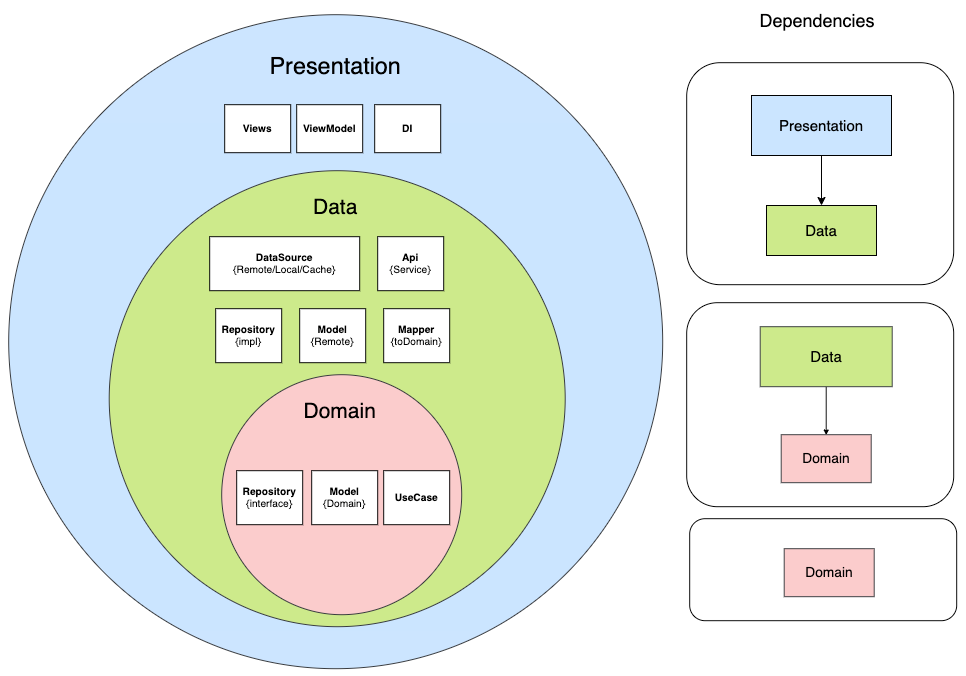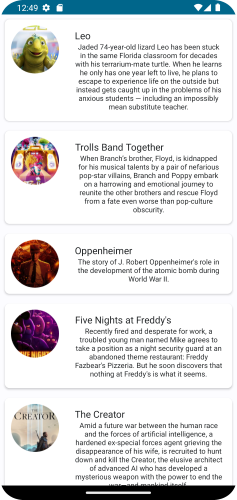Movies App
7 min readDec 2, 2023
- In this article we will create movies app using clean architecture, MVVM and jetpack compose.
- It will show a movie list to users. The users can see all the details of the movie in the list
- When user scrolls more movies are shown to the user
App Architecture
- This app follows MVVM and clean architecture.


App Screenshots

UI Layer
@Composable
fun MovieScreen(
viewModel: MovieViewModel = hiltViewModel()
) {
val res = viewModel.res.value
if (res.isLoading)
Box(modifier = Modifier.fillMaxSize(), contentAlignment = Center) {
CircularProgressIndicator()
}
if (res.error.isNotEmpty()) {
Box(modifier = Modifier.fillMaxSize(), contentAlignment = Center) {
Text(text = res.error)
}
}
if (res.data.isNotEmpty()) {
LazyColumn {
items(
res.data,
key = {
it.id!!
}
) { res ->
EachRow(res = res)
}
}
}
}
@Composable
private fun EachRow(
res: Movies.Results
) {
Card(
modifier = Modifier
.fillMaxWidth()
.padding(8.dp),
elevation = CardDefaults.cardElevation(
defaultElevation = 2.dp
),
colors = CardDefaults.cardColors(
containerColor = Color.White
),
shape = RoundedCornerShape(8.dp)
) {
Row(
modifier = Modifier.fillMaxWidth()
) {
Image(
painter = rememberAsyncImagePainter(
model = ImageRequest.Builder(LocalContext.current)
.data("${ApiService.IMAGE_URL}${res.poster_path}")
.placeholder(R.drawable.ic_launcher_foreground)
.crossfade(true)
.transformations(CircleCropTransformation())
.build()
),
contentDescription = "",
modifier = Modifier
.size(100.dp)
.padding(10.dp)
)
Column(
modifier = Modifier
.fillMaxWidth()
.padding(16.dp)
.align(CenterVertically)
) {
Text(
text = res.original_title!!, style = TextStyle(
fontSize = 16.sp
),
textAlign = TextAlign.Center
)
Text(
text = res.overview!!, style = TextStyle(
fontSize = 12.sp
),
textAlign = TextAlign.Center
)
}
}
}
}View
- All the ui logic to show movie list is written in the
MovieScreencomposable. - We have done dependency injection of
MovieViewModelin the primary constructor - We are first fetching
resultfrom the internet using theviewmodel. - If the result is in loading state we are showing a circular progress indicator.
- If the result is in error state we are showing an
errortext. - If the result has some data then we are passing that data to
LazyColumn items, which using composable functionEachRowto show the data EachRowcomposable is usingcardto show movie detailsCardis usingrowto place elements horizontally which containsimageandcolumnImageis used to show movie poster from result data.Columncontains two texts placed vertically. First text is used to show movie title and second text is used to show movie overview from result data.
Presentation Layer
@HiltViewModel
class MovieViewModel @Inject constructor(
private val useCase: MovieUseCase
) : ViewModel() {
private val _res: MutableState<MovieState> = mutableStateOf(MovieState())
val res: State<MovieState> = _res
init {
viewModelScope.launch {
useCase.getMovies()
.doOnSuccess {
_res.value = MovieState(
data = it!!
)
}.doOnFailure {
_res.value = MovieState(
error = it?.message!!
)
}.doOnLoading {
_res.value = MovieState(
isLoading = true
)
}.collect()
}
}
}
data class MovieState(
val data: List<Movies.Results> = emptyList(),
val error: String = "",
val isLoading: Boolean = false
)ViewModel
- Here
MovieViewModelis providing data to the UI and followingMVVMarchitecture. MovieViewModelis annotated withHiltViewModelso that it can injected wherever needed(MovieScreen)- Here
useCaseor domain layer dependency is injected in the primary constructor. - Here
MovieViewModelis fetching data fromuseCaseusing coroutines then assigning it toMovieStatedata class, thus followingclean architecture.
Domain Layer
class MovieUseCase @Inject constructor(
private val repo: MovieRepository,
private val mapper: MovieMapper
) {
suspend fun getMovies(): Flow<ApiState<List<Movies.Results>?>> {
return repo.getMovies().map { results ->
results.map {
mapper.fromMap(it)
}
}
}
}- Here
MovieUseCaseis acting as a domain layer which contains only business logic and no reference to UI or view - Here repository and mapper dependency is injected in primary constructor.
- It has a suspend fun
getMovieswhich when called from a coroutine will fetch result from repository, transform data into API state usingmapperwhich will contain data, error message and api states(success, failure and loading). RepositoryModuleprovidesMovieRepositoryinstance toMovieUseCaseMovieMapperinstance is provided here by using inject annotation inMovieMapperclass before primary constructor.
Data Layer
class MovieRepositoryImpl @Inject constructor(
private val apiService: ApiService
) : MovieRepository, BaseRepository() {
override suspend fun getMovies(): Flow<ApiState<Movies>> = safeApiCall {
apiService.getMovies()
}
}Repository
- Here we are using
MovieRepositoryImplclass to fetch data from internet usingApiServiceinterface - Here
ApiServicedependency is injected in the primary constructor MovieRepositoryImplis implementingMovieRepositoryinterface and abstract classBaseRepositorywhich contains suspend func safeApiCallNetworkModuleprovidesApiServiceinstance by integrating base url and moshi components- Notice
MovieRepositoryImplis using an suspend functionsafeApiCallto process fetched data. - if the request is successful it returns the data my mapping it to
ApiStatefor further processing, and throws exception in case of any errors. - Other scenarios it handles are if the request was not sent, if the response failed, if the response was successful with null data and an error or without any error.
Model
data class Movies(
val page: Int?,
val results: List<Results?>?
) {
data class Results(
val id:Long?,
val original_title:String?,
val overview:String?,
val poster_path:String?,
val vote_average:Float?
)
}- Above is the
Moviesdata model, It will be used to store response from the internet Resultsis one of the fields ofMovies.Resultsitself contains many fields so we have written it insideMovies.- Both
MoviesandResultscan have many other fields but we have only written the fields which we want to fetch. Like — Movies — total_pages, total_results, Results — release_date, popularity, vote_count etc.
Api Service
interface ApiService {
companion object {
const val BASE_URL = "https://api.themoviedb.org/3/"
const val IMAGE_URL = "https://image.tmdb.org/t/p/w500"
}
@GET("discover/movie?api_key=1234")
suspend fun getMovies(): Response<Movies>
}Retrofitobject is created using BASE_URL ofApiServiceinterfacegetMoviessuspend fun is used to fetch data from the internet.getMoviesgenerates a get request with the help of BASE_URL, query and api_keyMoviesdata class will be used to fetch specific fields of response and store it.- If you need to pass fields to get the response you can add it in the primary constructor of
getMovies.
Dependency Injection
- we are using dagger-hilt to provide dependency injection inside the app
NetworkModuleandRepositoryModuleare used to provideApiServiceandMovieRepositorydependency to data layer and domain layer respectively.- we are providing
MovieViewModeldependency by annotating it withHiltViewModel - We have annotated
MainActivitywithAndroidEntryPoint, so that we can inject instances inside it. like — we have have inject viewmodel insideMainActivity AndroidEntryPointannotation make the component class(activity, fragments, views, services, and broadcast receiver) ready for injection.- We annotate the
BaseApplicationclass withHiltAndroidApp. - This will make this class trigger Hilt’s code generation which will have the base class for our application and it acts as the application-level dependency container.
//NetworkModule object
@Module
@InstallIn(SingletonComponent::class)
object NetworkModule {
@Provides
@Singleton
fun provideMoshi(): Moshi = Moshi
.Builder()
.run {
add(KotlinJsonAdapterFactory())
build()
}
@Provides
@Singleton
fun provideApiService(moshi: Moshi): ApiService =
Retrofit.Builder()
.run {
baseUrl(ApiService.BASE_URL)
addConverterFactory(MoshiConverterFactory.create(moshi))
build()
}.create(ApiService::class.java)
}
//MovieRepository abstract class
@Module
@InstallIn(ViewModelComponent::class)
abstract class RepositoryModule {
@Binds
abstract fun provideMovieRepository(
repo: MovieRepositoryImpl
): MovieRepository
}Retrofitobject is created using BASE_URL ofApiServiceinterfaceRepositoryModuleprovidesMovieRepositoryinstance toMovieUseCase- Dagger 2 is a compile-time android dependency injection framework
- basics annotations used in dagger2 are
- Module — This annotation is used over the class which is used to construct objects and provide the dependencies.
- Inject — This is used over the fields, constructor, or method and indicate that dependencies are requested. Use constructor injection with
Injectto add types to the Dagger graph whenever it’s possible. when its not use binds and provides. - Singleton — This is used to indicate only a single instance of dependency object is created.
- Binds — Use
Bindsto tell Dagger which implementation an interface should have. - Provides — Use
Providesto tell Dagger how to provide classes that your project doesn’t own. - So the execution flow in a dagger app would be:
- The android app starts and the MyApplication class builds the graph, parsing the Module annotated classes and keeping an instance of it.
- Then, the classes declared in the module can access its objects just injecting themselves in the object graph. Gradle then will evaluate their Inject annotations and perform the dependency injections.
Pre-Configuration
- we need to add internet permission in the manifest file so that app can connect to the internet.
- we need to add
BaseApplicationasandroid:nameinside application tag in manifest file, so that app knows this is our application class.
API Key
- You can generate your api key from tmdb official site.
Let’s keep this article going, clap 👏 and star ⭐ the GitHub repository.
